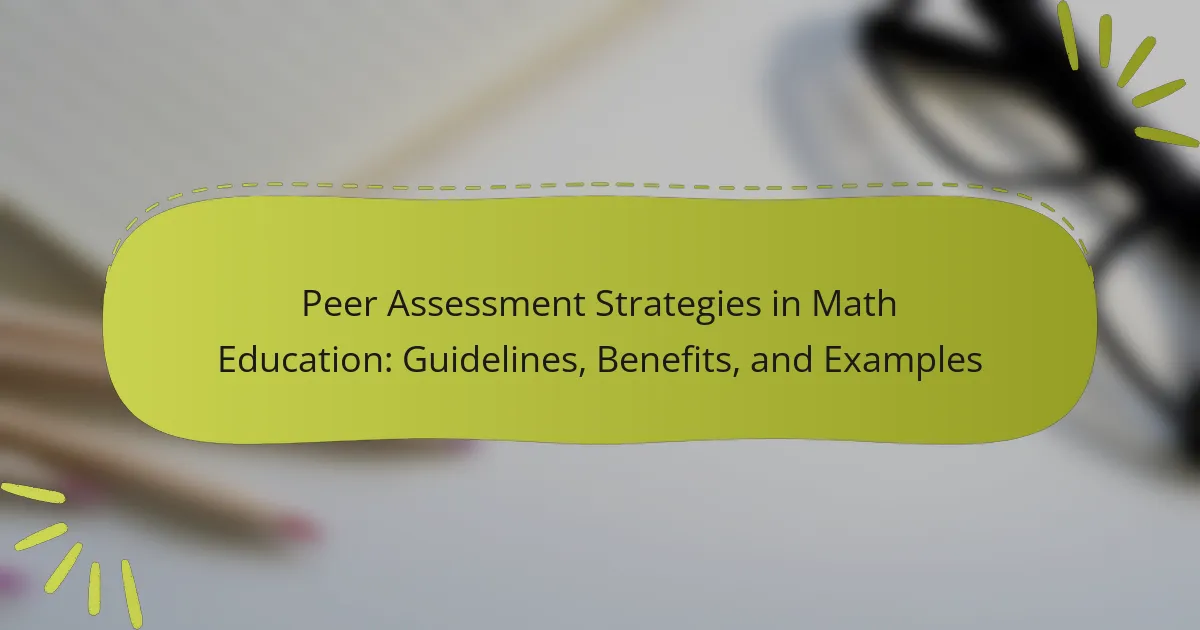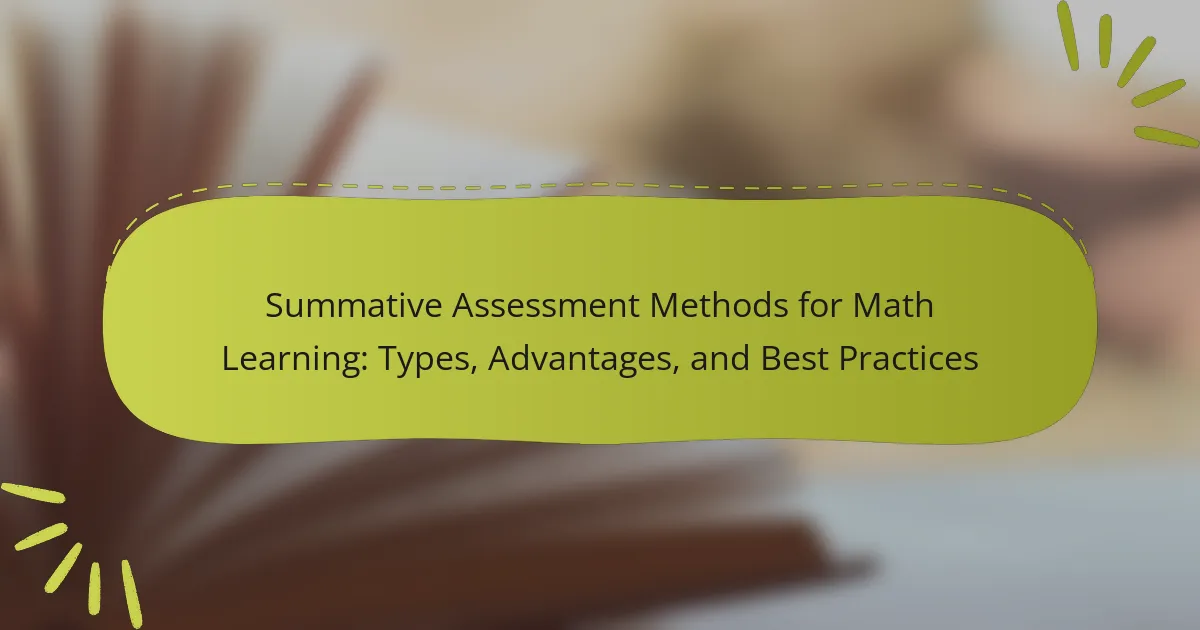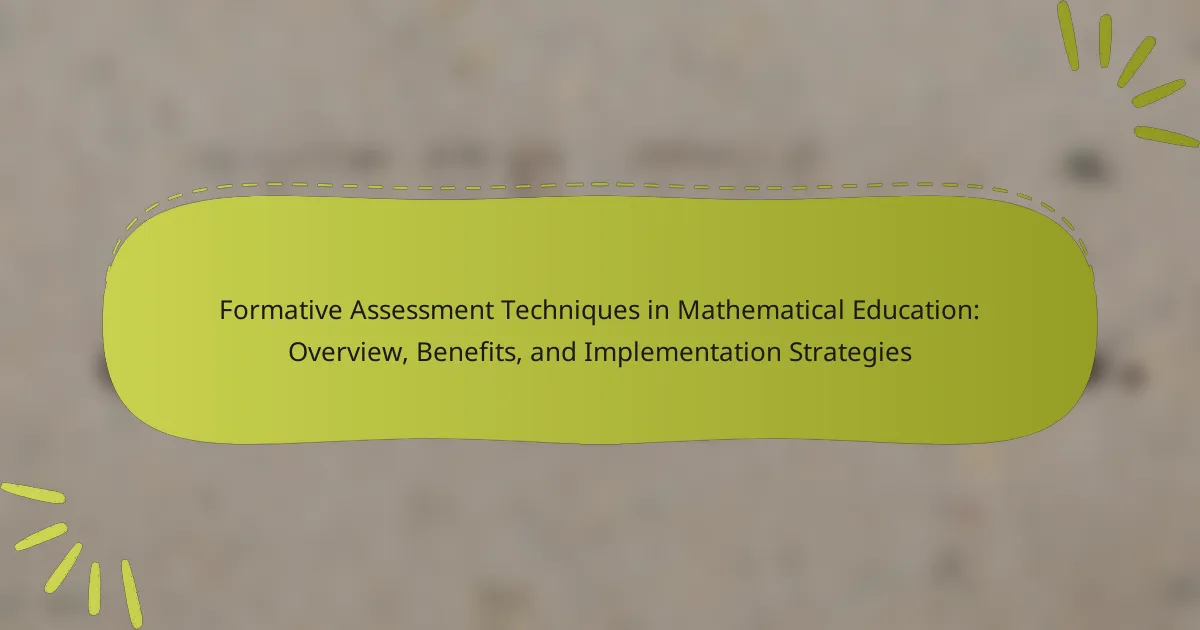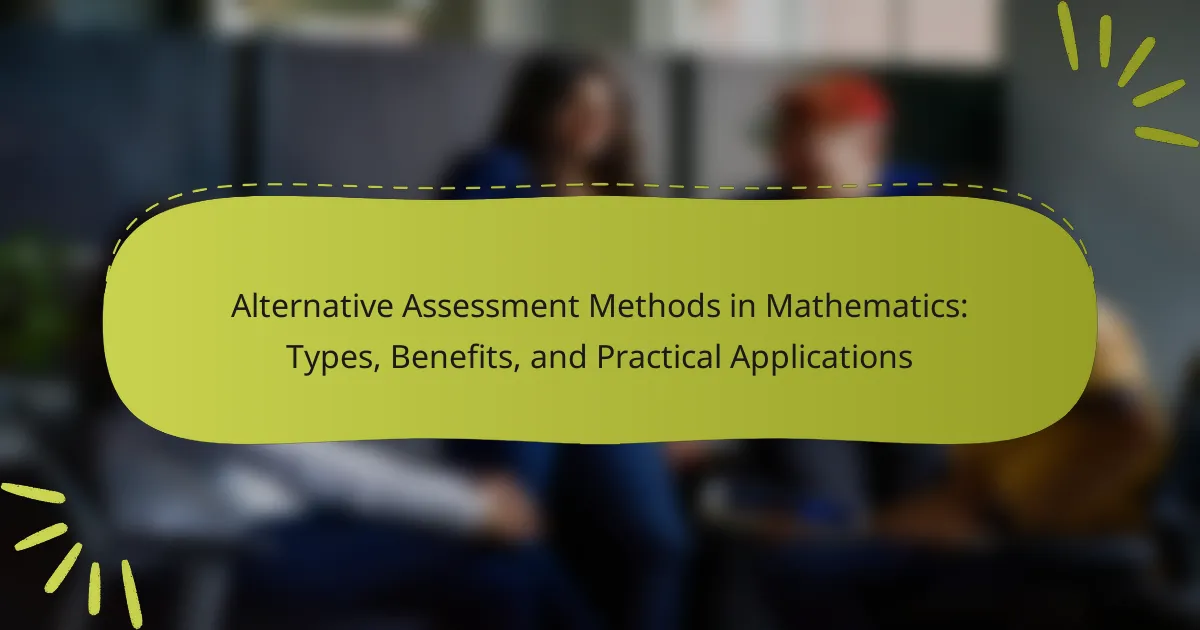Collaborative assessment techniques in math education are methods that enable students to work together to evaluate their understanding and skills. These techniques, which include peer assessments, group projects, and collaborative problem-solving tasks, foster teamwork and communication among learners. Research indicates that such collaborative assessments enhance student engagement and improve learning outcomes, leading to higher achievement and better retention of information. Effective implementation involves clear learning objectives, diverse group formation, structured collaboration guidelines, and regular feedback mechanisms, all aimed at creating a supportive and interactive learning environment.
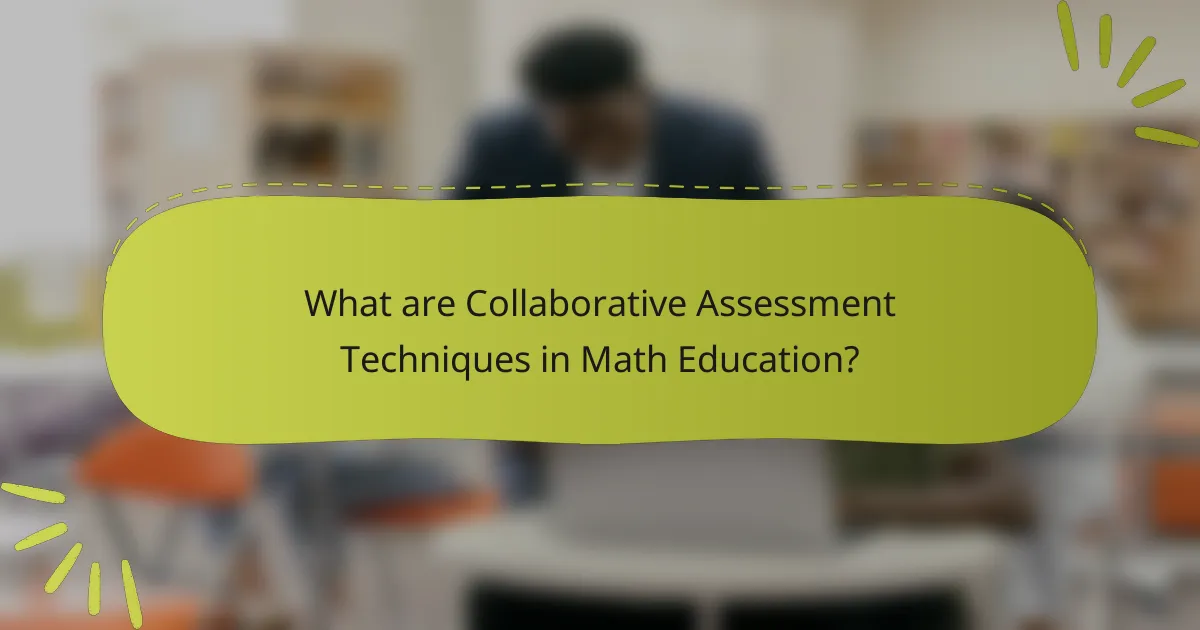
What are Collaborative Assessment Techniques in Math Education?
Collaborative assessment techniques in math education involve methods where students work together to evaluate their understanding and skills. These techniques promote teamwork and communication among learners. Examples include peer assessments, group projects, and collaborative problem-solving tasks. Research shows that collaborative assessments can enhance student engagement and improve learning outcomes. A study by Johnson and Johnson (1999) found that cooperative learning strategies lead to higher achievement and greater retention of information. By integrating these techniques, educators can create a more interactive and supportive learning environment.
How do Collaborative Assessment Techniques differ from traditional assessment methods?
Collaborative Assessment Techniques differ from traditional assessment methods in their focus on group interaction and shared learning. Traditional assessments often emphasize individual performance and standardized testing. In contrast, collaborative assessments encourage teamwork and collective problem-solving. They allow students to engage in discussions, share ideas, and learn from one another. This approach fosters deeper understanding and critical thinking skills. Research indicates that collaborative assessments can enhance student engagement and motivation. Studies show that students involved in collaborative assessments often perform better academically compared to those who rely solely on traditional methods.
What are the key characteristics of Collaborative Assessment Techniques?
Collaborative Assessment Techniques involve shared evaluation methods that promote teamwork and peer interaction. These techniques encourage active participation among students. They often include group projects and peer assessments. Collaborative assessments foster critical thinking and problem-solving skills. They also enhance communication and social skills. Feedback is typically provided by both peers and instructors. These techniques can improve student engagement and motivation. Research shows that collaborative assessments lead to deeper understanding of content.
How do these techniques engage students in the learning process?
Collaborative assessment techniques engage students in the learning process by promoting active participation and teamwork. These techniques encourage students to work together on problem-solving tasks. This collaboration fosters communication skills and peer learning. Research indicates that students involved in collaborative assessments demonstrate improved understanding of mathematical concepts. According to a study by Johnson and Johnson (2009), cooperative learning enhances academic achievement and increases student motivation. Engaging in group discussions allows students to articulate their thoughts and clarify their understanding. This interaction leads to deeper cognitive processing of the material. Overall, these techniques create a dynamic learning environment that enhances student engagement and learning outcomes.
What are the benefits of using Collaborative Assessment Techniques in Math Education?
Collaborative Assessment Techniques in Math Education enhance student engagement and foster a deeper understanding of mathematical concepts. These techniques encourage peer interaction, which promotes critical thinking and problem-solving skills. Students benefit from diverse perspectives, leading to improved communication skills. Research shows that collaborative assessments can increase retention of mathematical knowledge. A study published in the Journal of Educational Psychology found that students who participated in collaborative assessments scored higher on standardized tests. Additionally, these techniques create a supportive learning environment, reducing anxiety associated with math. Overall, the benefits include enhanced understanding, improved skills, and a positive classroom atmosphere.
How do these techniques enhance student learning outcomes?
Collaborative assessment techniques enhance student learning outcomes by promoting active engagement and deeper understanding. These techniques encourage students to work together, fostering communication and critical thinking skills. Research shows that collaborative learning can lead to higher achievement levels. For instance, a study published in the Journal of Educational Psychology found that students engaged in collaborative assessments scored 20% higher on standardized tests. Additionally, these techniques help students retain information longer, as they are more likely to remember concepts discussed in a group setting. Overall, collaborative assessments create a more interactive and supportive learning environment, leading to improved academic performance.
What impact do Collaborative Assessment Techniques have on student motivation?
Collaborative Assessment Techniques significantly enhance student motivation. These techniques promote active participation and engagement among students. Research indicates that when students work together, they feel a sense of belonging. This social interaction fosters intrinsic motivation. Additionally, collaborative assessments allow for peer feedback, which can boost confidence. A study published in the Journal of Educational Psychology found that students involved in collaborative assessments reported higher motivation levels. This increase is attributed to shared goals and accountability within groups. Overall, these techniques create a positive learning environment that encourages students to take ownership of their learning.
What challenges might educators face when implementing Collaborative Assessment Techniques?
Educators may face several challenges when implementing Collaborative Assessment Techniques. One challenge is the potential for unequal participation among students. Some students may dominate discussions while others remain passive. This can lead to imbalanced group dynamics. Another challenge is time management. Collaborative assessments often require more time for planning and execution than traditional assessments. Additionally, educators may struggle with aligning these techniques to curriculum standards. Ensuring that collaborative assessments meet learning objectives can be complex. There may also be resistance from students accustomed to individual assessments. This resistance can hinder the effectiveness of collaborative techniques. Finally, educators may lack training in facilitating collaborative assessments. Without proper training, they may find it difficult to guide student interactions effectively.
How can teachers address potential resistance from students?
Teachers can address potential resistance from students by fostering a supportive learning environment. They should actively listen to student concerns and validate their feelings. Building rapport with students can enhance trust and reduce resistance. Implementing collaborative assessment techniques encourages student engagement. Providing choices in assessments can empower students and increase their motivation. Offering constructive feedback helps students understand their progress and areas for improvement. Research shows that a positive teacher-student relationship correlates with increased student participation. According to a study by Pianta et al. (2008), strong relationships can lead to better academic outcomes.
What logistical issues may arise during implementation?
Logistical issues during implementation may include coordination challenges among educators. Effective collaboration requires clear communication and scheduling. Conflicts in availability can hinder group participation. Resource allocation may also present difficulties, such as insufficient materials for assessments. Additionally, training needs for educators may be overlooked, leading to inconsistent application of techniques. Technical issues with digital tools can disrupt the assessment process. Finally, varying student readiness levels can complicate the assessment’s effectiveness. These factors collectively impact the success of collaborative assessment techniques in math education.
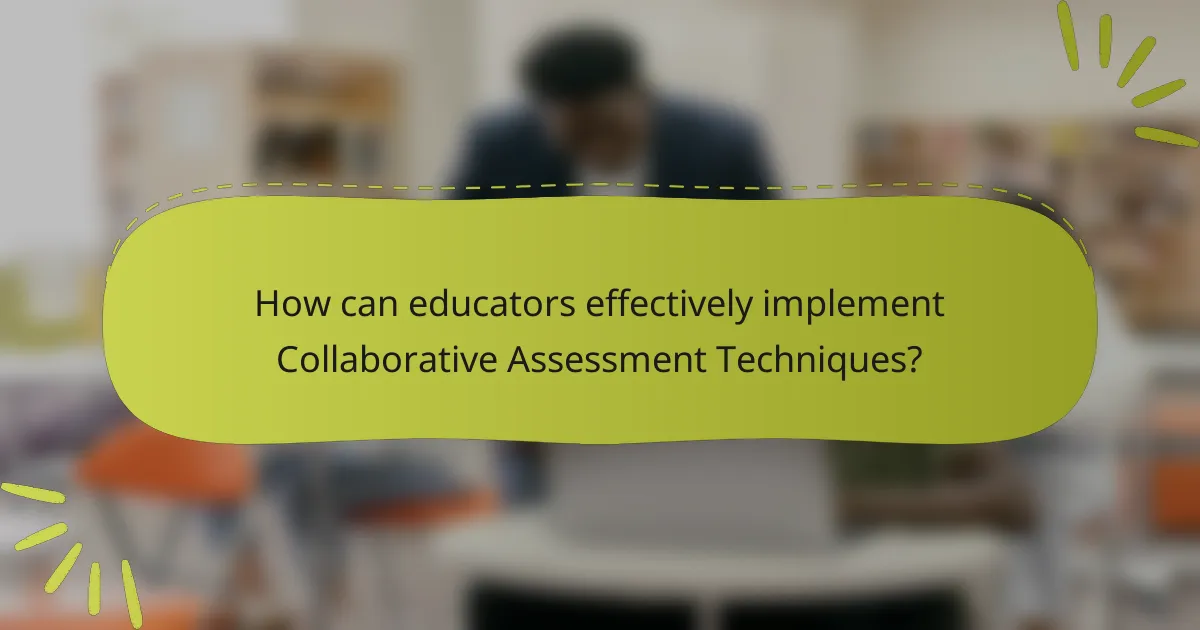
How can educators effectively implement Collaborative Assessment Techniques?
Educators can effectively implement Collaborative Assessment Techniques by fostering an environment of teamwork and communication. They should begin by clearly defining learning objectives and assessment criteria. Next, educators can form diverse groups to encourage varied perspectives. Regular check-ins can help monitor group dynamics and progress. Additionally, providing structured guidelines for collaboration enhances focus and productivity. Incorporating peer feedback mechanisms allows students to learn from each other. Finally, reflecting on the collaborative process helps improve future assessments. Research indicates that collaborative assessments improve student engagement and understanding (Johnson & Johnson, 2014).
What steps should educators take to introduce these techniques in the classroom?
Educators should start by familiarizing themselves with collaborative assessment techniques. They can then design lesson plans that incorporate these methods. Next, educators should provide clear instructions and expectations to students. Facilitating group discussions can enhance understanding and engagement. Educators should also create a supportive environment that encourages collaboration. Assessing group dynamics and individual contributions is essential. Finally, gathering feedback from students can help refine the approach. These steps align with research indicating that collaborative assessments improve student learning outcomes.
How can teachers create a supportive environment for collaboration?
Teachers can create a supportive environment for collaboration by fostering open communication. Encouraging students to share their ideas promotes engagement. Establishing clear expectations for group work helps students understand their roles. Providing necessary resources ensures all students can contribute effectively. Creating a safe space for sharing ideas reduces fear of judgment. Implementing regular feedback sessions allows students to improve collaboratively. Incorporating diverse groupings enhances learning through varied perspectives. Research shows that supportive environments lead to higher student achievement and satisfaction.
What resources are available to assist educators in this process?
Resources available to assist educators in collaborative assessment techniques in math education include professional development workshops, online courses, and instructional guides. Professional development workshops often provide hands-on training and strategies for implementing collaborative assessments effectively. Online courses, such as those offered by platforms like Coursera and EdX, cover various assessment techniques and collaborative learning strategies. Instructional guides, published by educational organizations, offer frameworks and examples for creating collaborative assessments in math. Additionally, peer-reviewed articles in educational journals provide evidence-based practices and insights into successful implementation. Resources from organizations like the National Council of Teachers of Mathematics (NCTM) also support educators with research and best practices in math education.
What strategies can enhance the effectiveness of Collaborative Assessment Techniques?
Utilizing structured group roles enhances the effectiveness of Collaborative Assessment Techniques. Assigning specific roles, such as facilitator, note-taker, and presenter, promotes accountability among participants. This strategy encourages active engagement and ensures that every group member contributes. Regular feedback sessions improve communication and clarify expectations. Implementing peer assessment fosters critical thinking and reflection on group performance. Research indicates that collaborative learning environments significantly boost student achievement in mathematics. A study by Johnson and Johnson (2014) found that structured collaboration leads to higher retention rates and deeper understanding of mathematical concepts.
How can technology be integrated into Collaborative Assessment Techniques?
Technology can be integrated into Collaborative Assessment Techniques by utilizing digital platforms for real-time feedback. Online tools facilitate group discussions and peer evaluations. Learning management systems enable the sharing of assessment rubrics and criteria. Video conferencing software allows remote collaboration among students. Interactive applications support problem-solving in teams. Data analytics can track group performance and individual contributions. These integrations enhance engagement and streamline the assessment process. Research shows that technology use in assessments improves student collaboration and learning outcomes.
What role does feedback play in these assessment methods?
Feedback plays a crucial role in collaborative assessment methods. It enhances student understanding by providing specific insights into their performance. Timely feedback helps identify strengths and areas for improvement. This process encourages active engagement among peers, fostering a supportive learning environment. Research shows that feedback can significantly boost learning outcomes. According to Hattie and Timperley’s meta-analysis, effective feedback can increase student achievement by up to 30%. Therefore, feedback is essential for guiding students through collaborative assessments in math education.
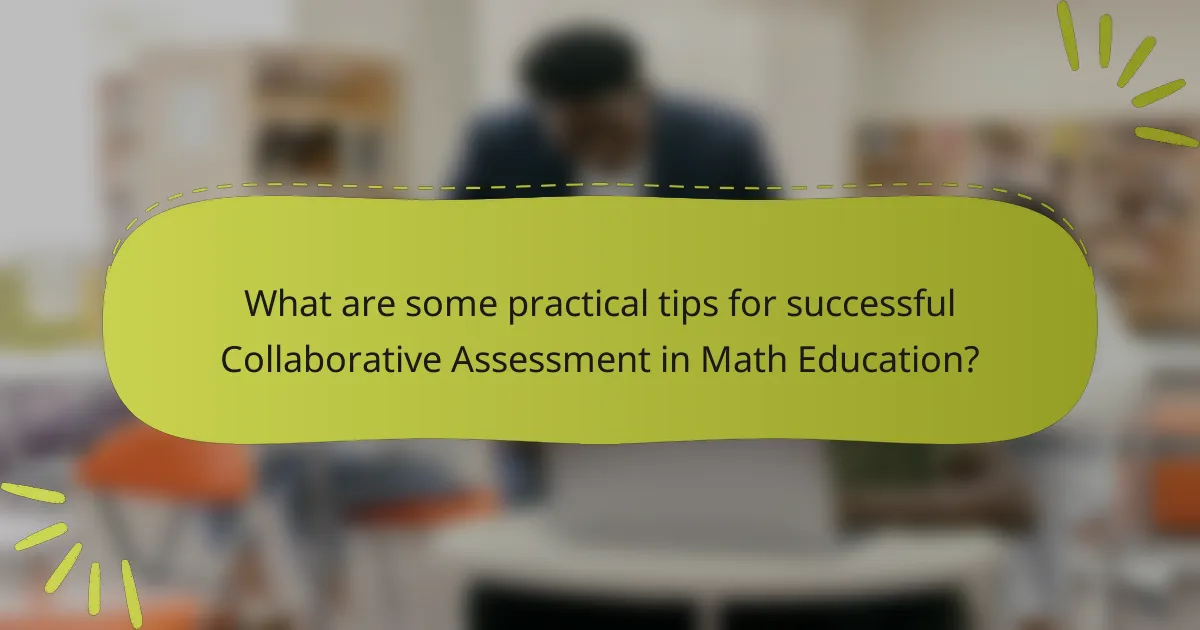
What are some practical tips for successful Collaborative Assessment in Math Education?
Successful Collaborative Assessment in Math Education involves clear communication and structured group activities. Establish specific roles within groups to enhance accountability. Use diverse assessment methods to cater to different learning styles. Provide timely and constructive feedback to guide improvement. Encourage peer evaluation to foster critical thinking and reflection. Set clear objectives for each collaborative task to maintain focus. Incorporate technology tools to facilitate collaboration and engagement. Regularly assess group dynamics to ensure equitable participation among all students.
How can educators assess the effectiveness of Collaborative Assessment Techniques?
Educators can assess the effectiveness of Collaborative Assessment Techniques by analyzing student performance and engagement. They should collect data on individual and group outcomes. This includes evaluating scores on assessments before and after implementing these techniques. Educators can also use surveys to gather student feedback on their experiences. Observations during collaborative activities provide insights into student interactions. Additionally, comparing performance across different groups can highlight the impact of these techniques. Research indicates that collaborative assessments can enhance learning outcomes when structured effectively. For instance, a study by Johnson and Johnson (2019) found improved academic performance in collaborative settings.
What metrics should be used to evaluate student progress?
Metrics to evaluate student progress include formative assessments, summative assessments, and standardized tests. Formative assessments are ongoing evaluations that provide real-time feedback. They can include quizzes, class discussions, and peer reviews. Summative assessments evaluate student learning at the end of an instructional unit. Examples are final exams and projects. Standardized tests measure student performance against a common standard. They provide comparative data on student achievement. Additionally, qualitative metrics like student self-assessments can offer insights into personal learning experiences. Research indicates that a combination of these metrics yields a comprehensive understanding of student progress.
How can teachers adjust their approach based on assessment results?
Teachers can adjust their approach based on assessment results by analyzing student performance data. They can identify areas where students struggle or excel. This allows for targeted instruction to address specific learning gaps. Teachers may implement differentiated instruction strategies to cater to diverse learning needs. They can also modify lesson plans based on the assessment feedback. Regularly revisiting assessment results helps in refining teaching methods. Research shows that responsive teaching improves student outcomes significantly. Adjustments based on data-driven insights foster a more effective learning environment.
What are common pitfalls to avoid when using Collaborative Assessment Techniques?
Common pitfalls to avoid when using Collaborative Assessment Techniques include lack of clear objectives. Without defined goals, assessments can become unfocused and ineffective. Another pitfall is inadequate preparation. Insufficient training for participants can lead to misunderstandings and poor collaboration. Additionally, failing to establish roles can result in confusion among team members. Over-reliance on technology may also hinder communication and engagement. Finally, neglecting to provide timely feedback can diminish the learning experience. Each of these pitfalls can undermine the effectiveness of collaborative assessments in math education.
How can educators ensure equitable participation among students?
Educators can ensure equitable participation among students by implementing collaborative assessment techniques. These techniques promote inclusivity and allow all students to contribute. Group work can be structured to balance participation. Assigning roles within groups ensures that each student has a responsibility. Using varied assessment methods accommodates different learning styles. Providing clear guidelines helps students understand expectations. Regular feedback encourages ongoing improvement and engagement. Research shows that equitable participation enhances learning outcomes and fosters a positive classroom environment.
What strategies can prevent groupthink in collaborative settings?
Encouraging diverse perspectives can prevent groupthink in collaborative settings. Implementing techniques such as assigning a devil’s advocate role fosters critical thinking. This role challenges prevailing opinions and promotes debate. Additionally, creating a culture of open communication allows all members to voice their thoughts. Regularly rotating group members can introduce fresh ideas and viewpoints. Establishing structured decision-making processes helps ensure thorough evaluation of options. Techniques like brainstorming sessions can generate a wide array of ideas. Finally, seeking external feedback from non-group members can provide unbiased insights. These strategies collectively enhance creativity and decision-making quality in collaborative environments.
Collaborative Assessment Techniques in Math Education focus on methods that promote teamwork and peer interaction among students to evaluate their understanding and skills. This article explores the differences between collaborative and traditional assessment methods, highlighting the key characteristics, benefits, and impact on student motivation and learning outcomes. It also addresses challenges educators may face during implementation and provides practical tips for effectively integrating these techniques in the classroom. Additionally, the article discusses the role of feedback, technology integration, and strategies to ensure equitable participation and prevent groupthink.
